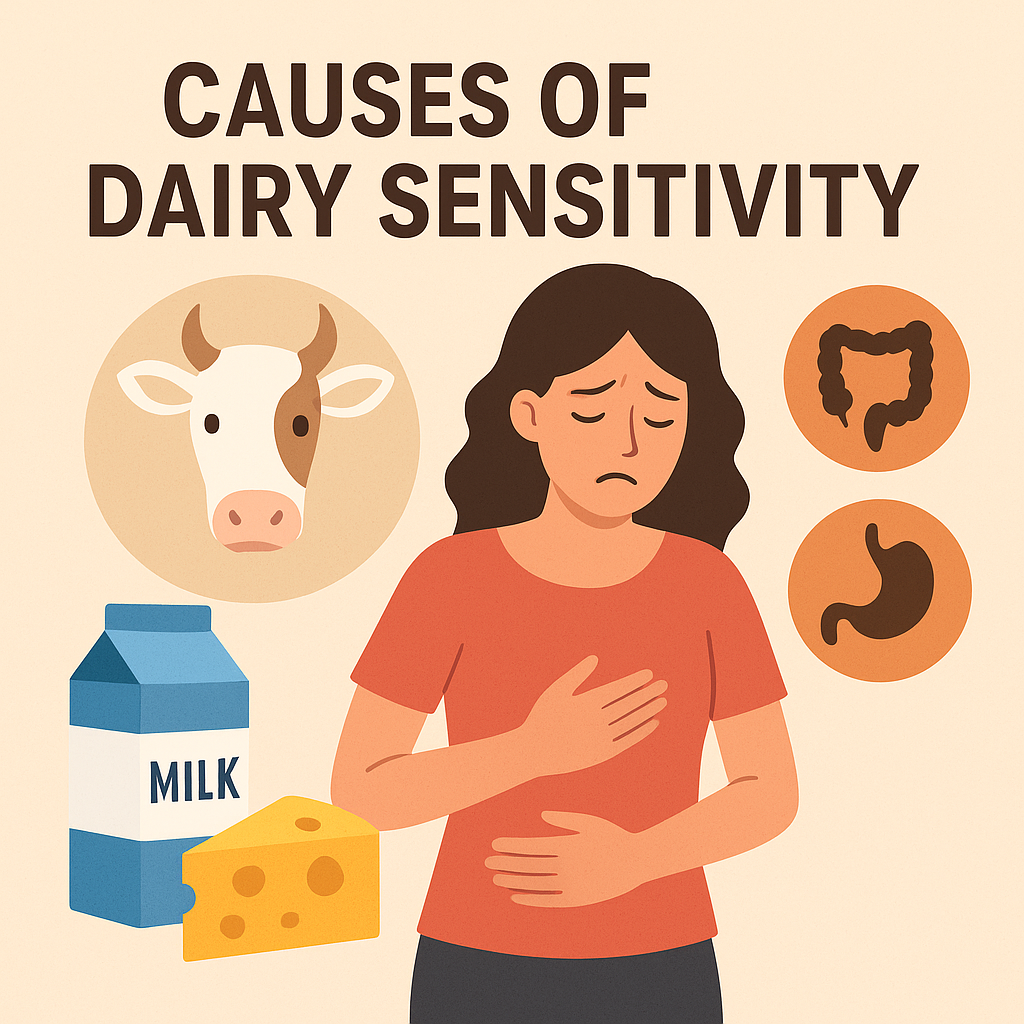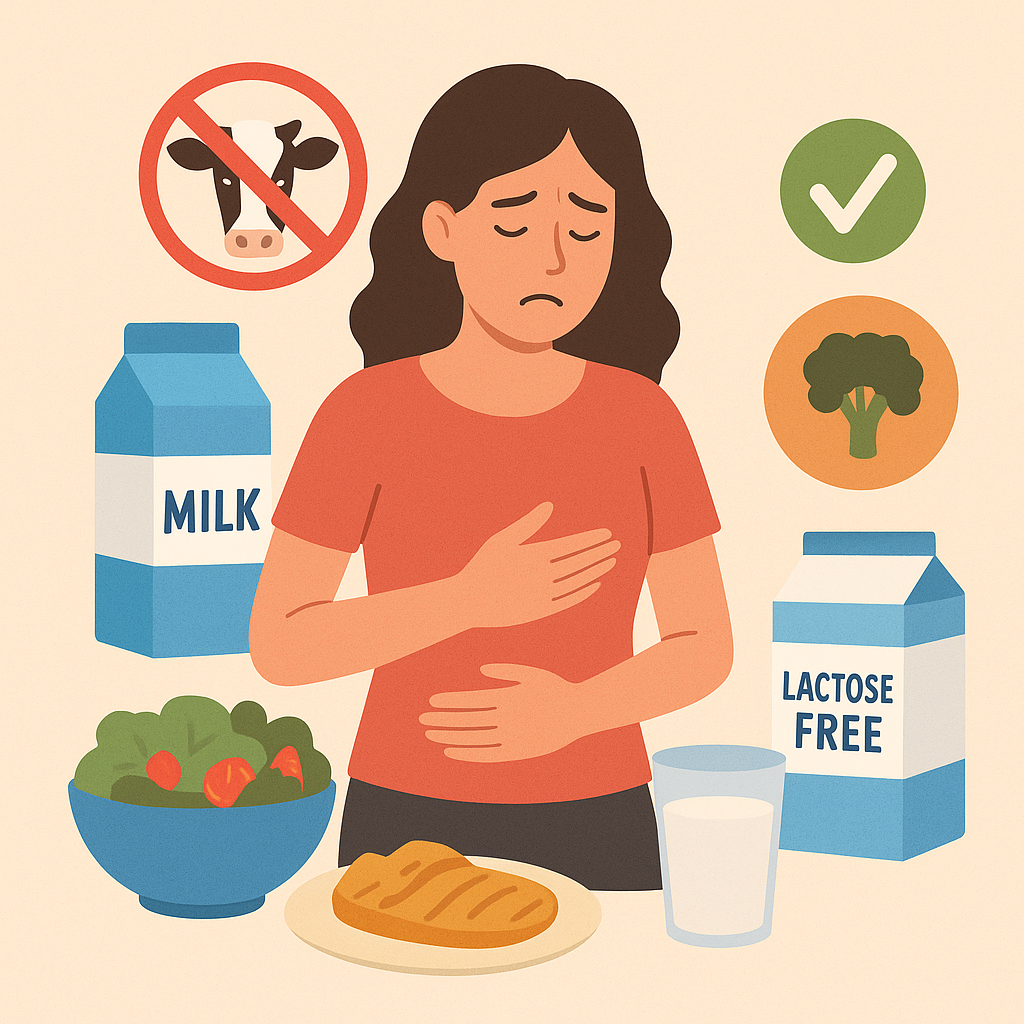In the current health conscious society, a good number of individuals are reconsidering their association with dairy. Milk and Dairy products contain a lot of calcium, proteins and vitamins, but not everyone can digest them. Others have mild digestive problems after taking dairy, whereas others have severe symptoms that are indicative of lactose intolerance.
Whereas the terms lactose intolerance and daily sensitivity (or dairy sensitivity) are used interchangeably, they are used to refer to different conditions, having different causes, symptoms, and management plans. The knowledge of these variations is critical towards being healthy in terms of digestion and making healthy choices in terms of diet.
What is Dairy Sensitivity?
Dairy sensitivity has the meaning of an overall intolerance or an unfavourable response to dairy products, which is not always related to lactose itself. In most instances, dairy sensitivity is the response of the immune system to specific proteins present in milk, like casein or whey. This reaction may lead to symptoms that are similar to lactose intolerance, and it may be difficult to differentiate between the two.
Important Properties of Dairy Sensitivity
- Disease brought about by an immune response or inflammation of milk proteins.
- Even in the case of lactose-free milk.
- The symptoms can consist of bloating, abdominal pain, fatigue, brain fog, joint pain, and skin reactions.
- Symptoms might not manifest immediately, and they might be several hours after consumption.
Causes of Dairy Sensitivity

Immune System Overreaction:
In sensitive individuals, the immune system mistakenly identifies milk proteins as harmful, leading to inflammation and gastrointestinal discomfort. This reaction is usually non-allergic (not IgE-mediated) but still triggers immune involvement.
Gut Barrier Dysfunction:
A compromised intestinal lining (“leaky gut”) can allow milk proteins to pass into the bloodstream, causing sensitivity symptoms.
Digestive Enzyme Imbalance:
Reduced levels of other digestive enzymes (beyond lactase) can lead to incomplete protein breakdown, increasing the likelihood of sensitivity.
Chronic Inflammation or Gut Dysbiosis:
Imbalances in gut microbiota can heighten immune reactivity to certain food proteins, including those in dairy.
Symptoms
- Digestive discomfort: bloating, mild cramps, or irregular bowel movements.
- Fatigue and brain fog: due to immune activation and inflammation.
- Skin reactions: acne, eczema, or redness after dairy consumption.
- Sinus or respiratory congestion: excess mucus or nasal blockage.
- Headaches or migraines: in sensitive individuals triggered by inflammatory responses.
- Joint or muscle aches: occasionally linked to low-grade inflammation from dairy sensitivity.
Diagnosis of Dairy Sensitivity
Dairy sensitivity (milk protein sensitivity) is more complex to diagnose because it often involves immune or inflammatory reactions rather than a single enzyme deficiency.
Common diagnostic approaches include:
- a. Elimination Diet:
The most practical and reliable method. Dairy products are completely removed from the diet for 2–4 weeks. If symptoms such as bloating, fatigue, congestion, or skin irritation improve, and then return after reintroducing dairy, sensitivity is likely. - b. Food Sensitivity Tests (Immunologic Testing):
Blood tests may measure IgG antibody responses to milk proteins (like casein or whey). However, these tests are supportive rather than definitive results must be interpreted alongside clinical history. - c. Gastrointestinal and Inflammatory Marker Testing:
Functional medicine practitioners may check for gut inflammation markers (like calprotectin or zonulin) or gut microbiome imbalance, which can contribute to dairy sensitivity. - d. Differential Diagnosis:
Since dairy sensitivity can mimic lactose intolerance, a doctor may first rule out lactose intolerance using breath or blood tests before investigating sensitivity to milk proteins.
What is Lactose Intolerance?
Lactose intolerance is a type of digestive disorder, on the other hand, that is caused by the failure of the body to digest a natural sugar known as lactose that is present in milk. This occurs when the small intestine fails to secrete the required amount of lactase enzyme, which is necessary to decompose lactose into simple sugars that can be absorbed.
In case the lactose is not digested in the gut, it ferments and produces gases, bloat, cramps, and diarrhoea. It is an ordinary condition in all parts of the world, and especially among adults in Asia, Africa, and South America.
The main Issues with Lactose Intolerance:
- Due to the low levels of the lactase enzyme
- Not an immune-related issue
- Also caused by foods that contain lactose, like milk, ice cream, and soft cheeses.
The symptoms are experienced 30 minutes to 2 hours after consuming dairy.
Causes of Lactose Intolerance
Lactase Deficiency (Primary Lactose Intolerance):
The most common form, caused by a natural decline in lactase production after childhood. This is genetically influenced and prevalent among adults of Asian, African, Hispanic, and Native American descent.
Secondary Lactose Intolerance:
Occurs when the small intestine is damaged due to illness or injury, reducing lactase production. Conditions like celiac disease, Crohn’s disease, gastroenteritis, or intestinal infections can trigger it.
Congenital Lactase Deficiency (Rare):
A rare genetic disorder where infants are born with little or no lactase enzyme due to a mutation in the LCT gene.
Developmental Lactose Intolerance:
Seen in premature infants whose digestive systems are not yet fully developed to produce adequate lactase.
Symptoms
- Bloating and abdominal distension – due to gas buildup in the intestines.
- Cramping or abdominal pain – especially in the lower belly.
- Excessive gas (flatulence) – from bacterial fermentation of lactose.
- Diarrhea – unabsorbed lactose draws water into the colon.
- Nausea – sometimes leading to vomiting, especially in severe cases.
- Gurgling stomach or borborygmi – audible intestinal sounds caused by gas movement.
Diagnosis of Lactose Intolerance
Lactose intolerance is diagnosed through clinical evaluation and specific tests that measure the body’s ability to digest lactose.
Common diagnostic methods include:
- a. Hydrogen Breath Test:
This is the most accurate and widely used test. After drinking a lactose-rich beverage, breath samples are collected at regular intervals. Elevated hydrogen levels indicate that lactose was not properly digested in the small intestine and was instead fermented by bacteria in the colon confirming lactase deficiency. - b. Lactose Tolerance Blood Test:
Measures blood glucose levels after lactose ingestion. If glucose levels do not rise significantly, it means the body is not breaking down lactose effectively. - c. Stool Acidity Test (for infants and young children):
Undigested lactose produces lactic acid and other fatty acids in the stool, lowering its pH. This test is useful for diagnosing lactose intolerance in babies and young children. - d. Genetic Testing:
Detects inherited LCT gene variants responsible for primary lactose intolerance. It helps identify individuals with a lifelong lactase deficiency rather than one caused by intestinal damage. - e. Elimination and Reintroduction Diet:
Temporarily removing lactose-containing foods for 1–2 weeks, followed by gradual reintroduction, helps confirm whether symptoms (bloating, gas, cramps) are linked to lactose consumption.
Dietary Strategies and Management

For Lactose Intolerance
Lactose intolerant individuals may sometimes be able to cope with the problem by changing their diet and using enzyme supplements:
Replace Lactose-Free Milk: Lactaid is a real milk that is treated with the lactase enzyme so that it is easier to digest.
Take Lactose Supplements: Lactose tablets can be taken to digest lactose-containing food.
Eat Dairy Alternatives: Soy, almond, oat and coconut milk are really good
Add Hard Cheeses and Yoghurt: It is lower in lactose and can be better tolerated.
For Dairy Sensitivity
Treatment of dairy sensitivity may need a more thorough dairy protein elimination:
- You have to avoid regular and lactose-free dairy products, but proteins in milk still exist.
- Find dairy-free options that are fortified with vitamin D and calcium.
- Pay attention to the anti-inflammatory foods such as fruits, vegetables, nuts, and seeds.
- Look at the labels of food carefully – dairy proteins may be contained in baked goods, soups and sauces.
Health Effects of Ignoring Dairy Problems
- The lack of attention to the issue of lactose intolerance or sensitivity to dairy can result in long-term digestive discomfort and nutrient imbalances.
- No treatment. Lactose intolerance may result in chronic diarrhoea, dehydration, and inflammation of the gut.
- Disregard of dairy sensitivity can provoke systemic inflammation, aggravate autoimmune disorders, and influence the energy level.
- In the long run, a deficiency of calcium may occur due to poor management of dairy, exposing them to osteoporosis and bone fractures.
Top Dairy Alternatives: Nutritional Comparison and Benefits
| Dairy Alternative | Key Nutrients (per 1 cup) | Calories (avg) | Protein | Calcium (Fortified) | Other Benefits | Best Uses |
|---|---|---|---|---|---|---|
| Almond Milk | Vitamin E (40–50% DV), small amounts of calcium & vitamin D (if fortified) | 30–50 kcal | 1 g | 20–45% DV | Low in calories and sugar; supports skin health due to high vitamin E; naturally lactose-free and vegan. | Smoothies, cereals, baking, coffee. |
| Soy Milk | Protein (7 g), calcium (fortified 30–40% DV), vitamin B12, potassium | 90–120 kcal | 7 g | 30–45% DV | Closest to cow’s milk in protein; heart-healthy isoflavones; supports muscle repair. | Cooking, cereals, tea/coffee, protein shakes. |
| Oat Milk | Fiber (β-glucan 2–3 g), iron, B vitamins, calcium (fortified 25–35% DV) | 100–130 kcal | 2–4 g | 25–35% DV | Rich, creamy texture; supports gut and heart health; naturally sweet. | Lattes, smoothies, baking, oatmeal. |
| Coconut Milk (Drink form) | Healthy fats (MCTs), iron, potassium | 70–90 kcal | <1 g | 10–25% DV | Supports energy metabolism; adds rich flavor; may aid digestion in small amounts. | Curries, soups, desserts, tropical drinks. |
| Cashew Milk | Healthy fats, small protein (1 g), vitamin E, magnesium | 25–60 kcal | 1 g | 20–35% DV | Creamy, slightly nutty; supports heart health; blends well in smoothies. | Smoothies, sauces, desserts, coffee creamers. |
Conclusion
Knowing the distinction between dairy sensitivity and lactose intolerance is important for maintaining good digestive and overall health. Symptoms of the two conditions are similar, their etiologies are different, as one is an enzyme deficiency, and the other is immune reactivity.
With the help of determining what kind of condition you have and implementing appropriate dietary interventions, including using lactose-free milk, plant-based substitutes, or no dairy at all, you will be able to experience enhanced digestion, increased energy, and overall balanced living.
Bear in mind, it is not only about dairy avoidance but also about listening to your body and discovering what makes you best. Conscious nutrition can make you find comfort and confidence and be able to maintain good health in the long run.

 Medically reviewed by
Medically reviewed by